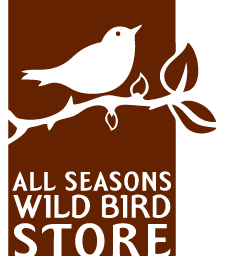Nestbox Basics
Tips for Bird Houses and Nest Boxes
General Nest Box Notes
- No perch is necessary. Birds that use birdhouses don’t need them.
- The perches can be used by predators to hold on to the house while they grope for eggs or young inside.
- Metal portal plates prevent house sparrows, woodpeckers and squirrels from widening the entrance hole.
- Mount the house so the entrance hole faces south/southeast, out of our prevailing winds. Place the house so that it gets the morning sun for warmth.
- When mounting on a pole or post use a baffle for further protection from predators.

Entrance Hole Size and House Spacing
- Bluebirds: 1 ½-inch to 2 ¼-inch entrance hole. We recommend putting up two houses within 20 feet of each other. One is for the Bluebirds and the other can provide housing for sparrows or swallows. The Bluebirds need 100 yards between nesting sites.
- Chickadee: 1 1/8-inch to 1 ¼-inch entrance hole. Have the houses up by late March or early April. Chickadees will more likely use the house
if they are familiar with it prior to nesting time. - House Wren: 1-inch to 1 1/8-inch entrance hole. Get the house up by early April.
- Wood Duck: 3 ½-inch to 4 ½-inch oval entrance hole. Please as near the water as possible in a fairly open site with the entrance hole at 6 feet above the ground or water. Be sure to use a baffle on the pole or post to protect them from raccoons. Place 3 inches or more of wood shavings to the cleaned out house by mid-March.
Bird Species |
Nest
|
Nest Box? |
Egg
|
Incubation |
Nestling |
Broods |
| American Goldfinch | 4–14-ft. upright forks
of bushes or trees (July/August) |
N | 5 pale bluish-white | Female; 12–14 days | 11–15 days | 1–2 |
| American Robin | 10–20-ft. shrubs, tree forks or nesting shelves | Shelf | 4 light blue | Female; 12–14 days | 14–16 days | 2–3 |
| Baltimore Oriole | 15–30-ft. shade trees | N | 4-5 pale greyish to bluish white marked with dark colors | Female; 13–15 days | 12–14 days | 1 |
| Black-capped Chickadee | 4–10-ft. tree cavities, birdhouses with 11/8-in. hole | Y | 6-8 white with
red-brown spots |
Female; 12–13 days | 16 days | 1–2 |
| Blue Jay | 10–25-ft. tree crotches or outer branches | N | 4-5 olive with brown/grey spots | Male and Female; 17–18 days | 16 days | 1 |
| Common Loon | ≤ 2 ft. near water on bare ground, floating bogs or shoreline vegetation | N | 1–2 olive brown, sparsely marked | Male and Female; 26–31 days | 1 day | 1 |
| Downy Woodpecker | 5–40-ft. evergreens, shrubs or vines | N | 4–5 white | Male and Female;
12 days |
20–22 days | 1 |
| Eastern Bluebird | 4–20-ft. tree cavities, birdhouses with
1 ½–2 ¼-in. hole |
Y | 4–5 pale blue
or white |
Female; 13-15 days | 15–20 days | 2–3 |
| House Wren | 4–12-ft. tree cavities, birdhouses with 11/8-in. hole | Y | 6–7 white, thickly speckled with reddish spots | Female; 12–15 days | 16–17 days | 2 |
| Mourning Dove | 10–25-ft. evergreens
or shrubs |
N | 2 white | Male and Female; 13–14 days | 12–13 days | 2–3 |
| Northern Cardinal | 1–15-ft. shrubs, vines or small trees | N | 3–4 greyish or bluish white with spots | Female; 12–13 days | 9–10 days | 2–3 |
| Rose-breasted
Grosbeak |
5–15-ft. forks of deciduous trees or shrubs | N | 3–5 pale blue
with brown spots |
Male and Female; 13–14 days | 9–12 days | 1–2 |
| Ruby-throated
Hummingbird |
10–20-ft. attached to small twigs or branches | N | 2 white | Female; 14–16 days | 14–28 days | 1–2 |
| Wood Duck | 5–50-ft. tree cavities
or bird houses |
Y | 10–15 dull white
or pale buff |
Female; 28–31 days | 1 day | 1 |

